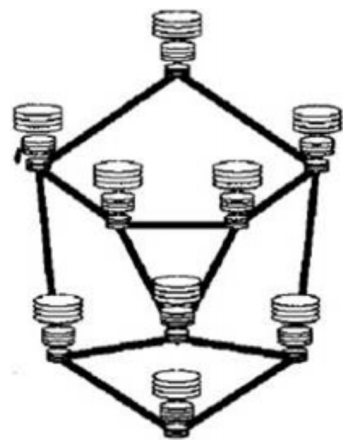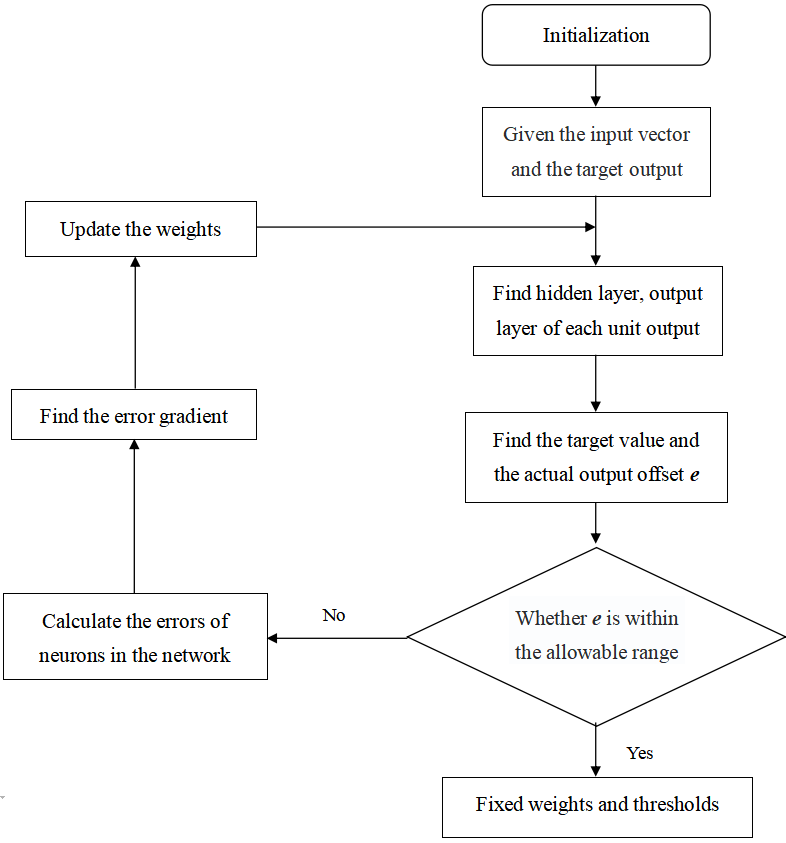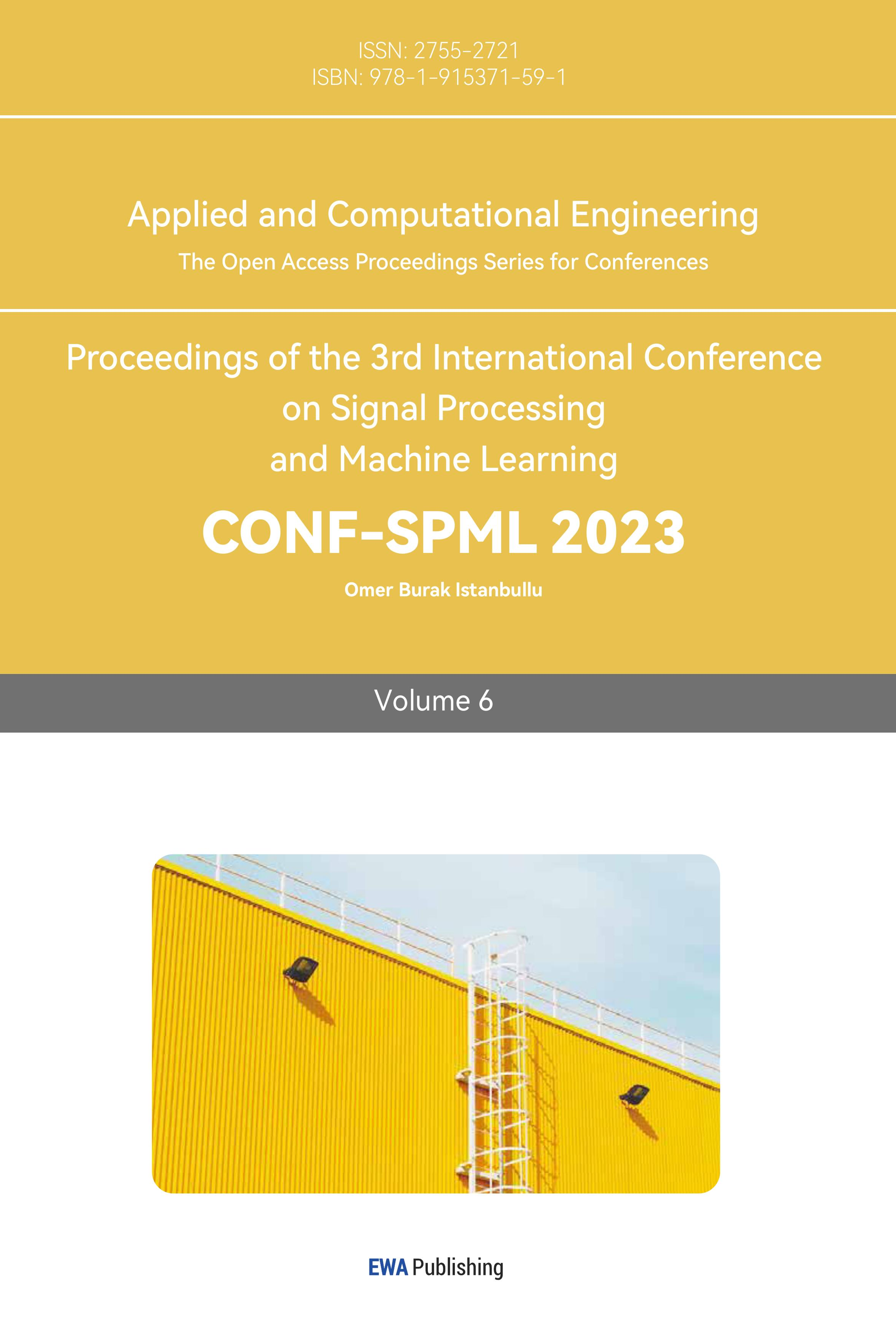1. Introduction
Face recognition is a technology of identity authentication based on facial features, which has a wide range of application prospects[1]. As early as 1950s, some scientists conducted some research on face recognition technology. People mostly investigated faces and facial silhouettes during the 1950s and 1980s, focusing on the extraction and study of structural aspects of the facial silhouette curve, however these studies did not yield any significant findings. With the rapid advancement of face recognition in the 1990s, numerous traditional techniques as well as some commercially available face recognition systems appeared. Researchers started to focus on face recognition in realistic settings in the 1990s as face recognition research became more in-depth. Nowadays, the rapid and effective face recognition applications that we come into contact with in various fields of social life are mainly as follows: The police search, identify, monitor, and track criminal suspects; Verification of documents, such as identification cards or passports in high-speed railway stations, railway stations and airports; Control of the flow of people entering and leaving the entrance. Face recognition technology is not only used in the above scenes. Face recognition will become more and more common as science and technology advance[2]. A special international conference was held because of the advancement and widespread use of facial recognition technology, which has attracted more scientists to this area of study. In the future, the application scope of face recognition will continue to expand, for example, in the fields of anti-terrorism, homeland security and social security, and in the fields of education and intelligent life, the media will have a series of greater breakthroughs[3]. In this paper, the development of face recognition, the basic process and the main methods are summarized, Research of face recognition has important significance in theory and technology.
2. Face Recognition Systems
2.1. Face Collection
When the acquisition object appears in the device range, the effective face image can be collected in different situations through the camera. Face collection is easily affected by image size, image resolution, light environment, blur length, and shade degree.
2.2. Face Detection
Face detection is to accurately calibrate the coordinates of the face and the area of the face in a picture and extract useful information(such as template features, color features, histogram features and Haar features, etc.) to achieve the purpose of face detection. A face detection algorithm is used to output the coordinates of the face in an image. However, the size and pose of the face in an image, the light intensity of the face in the image, or the integrity of the face in the image will affect the accuracy of face detection, which are also several core problems to be solved by the face detection algorithm. At present, face detection falls into two main types: face detection technology based on structural features and face detection technology based on statistical features[4].
2.2.1. Face detection based on structural features. This method is based on the geometric shape, gray level, texture, and other features of the image, which is described by the vector representing the face features, and uses the distribution law of the face in a certain feature space to detect the face. However, in the complex background, the detection results are easily disturbed.
2.2.2. Face detection based on statistical features. According to the principle of statistics, this approach views the face region as a pattern and conducts statistical analysis on a substantial number of “face” and “non-face” samples, according to the algorithm of face image screening and classification to construct a classifier. Face detection can be performed on the input image according to the classifier. This method requires the support of large data sets, which is very time-consuming and energy-consuming, which makes the method difficult.
2.3. Image Preprocessing
The image is preprocessed based on the results of face detection to serve the process of face feature extraction. Face image acquisition system often cannot be directly used because of various factors, so we need to collect image preprocessing such as light compensation, gray transformation, median filtering, and geometric correction.
2.4. Feature Extraction
Utilizing techniques like face geometric characteristics(like curvature, angle, etc.), algebraic features(like matrix feature vector, etc.), eigen face, moire patten, and others, this procedure aims to extract human facial traits and identify the detected face[5].
2.5. Matching and Recognition
The final identification process is achieved by comparing the collected face image data with the face image data stored in the database and find out the face with the highest matching degree. The key to this step is choosing the appropriate face expression method and matching algorithm.
3. The Main Methods of Face Recognition
3.1. Face Recognition Based on Facial Geometric Features
Face recognition based on facial geometric features is an intuitive method. According to the development of feature vectors, geometric features can be representative parts of the face (eyes, nose, mouth, eyebrows, etc.) and geometric relationships between them(relative location and distribution of geometric parameters, etc.), to identify and determine the face. This method has the advantages of a fast recognition rate, a small memory, and low sensitivity to light changes. However, the extraction of geometric features is easily affected by factors such as facial occlusion and expression changes, and many details in the whole image are ignored. Therefore, this method has a low recognition rate and is not a mainstream usage scheme. Recent research on this method has become less and less in recent years.
3.2. Face Recognition Based on Template Matching
The application based on template matching is quite common and belongs to one of the simplest pattern recognition methods. This method mainly uses the autocorrelation between the computed template and the image gray level to realize the determination function. Template matching is classified into static matching and elastic matching[6].
Static template matching is given in advance with some different standard sample face templates. These face templates contain different face features of the aspect ratio template. To test the face image global range search, according to the size of the similarity between the comparison and recognition, test whether it contains the target image. The operation of this method is not complicated, but the recognition accuracy cannot be guaranteed in the face of posture and size changes, so this method is not widely used at present.
Elastic template matching is an algorithm based on dynamic link structure. This method uses an attribute graph to describe the face. An optimized search strategy is used to locate several predefined facial key feature relationships for any input face image. Then the matching method is used to compare the face image information stored in the image library with the collected face image information to judge the matching degree of the two, and then the face image with the highest similarity is selected from the face image library. The face recognition method based on elastic map matching takes into account the local details of the face and retains the spatial distribution information of the face. Compared with the static template matching method, it is more flexible and robust. However, this method has a large amount of calculation, a high dependence on the initial values of parameters, and it is easy to fall into the local minimum, and the calculation time is long. Lades M. et al. originally used this method to recognize faces in 1992 and saw promising results. The edge of the map is indicated by the distance between two knots, and the feature vector markers(as shown in Figure 1) are created by the Gabor wavelet decomposition of the picture location by the nodes represented in the sparse graph. A model map that closely resembles a face image is first chosen for the matching procedure, after which the locations of all of the points on the map are compared, a distorted map is created. The position of a point in the form serves as the node’s location[5].

Figure1. Face sparse graph[5]
3.3. Eigen Face
Eigen Face proposed by Turk and Pentland of the MIT laboratory has made significant achievements in the field of face recognition[7]. This algorithm is simple and effective, which is also called principal component analysis(PCA). The goal is to use machine learning to encode and decode faces. A collection of “standardized face components” known as a set of feature faces is created by statistical analysis of several face photos. Because this method uses statistical databases rather than digital images, each facial characteristic is given a numerical value. So the face is converted into a combination of these values in different percentages. Now, Eigen Face and Normalized Correlation have become the benchmark algorithms for face recognition performance testing. In fact, the information hidden in the face sample set and the structural relationship of the face can be reflected from the eigen face. Eigen subfaces including eigen eyes, eigen jaws, and eigen lips generate subspace in the corresponding image space, which is called subface space. If the window images meet the conditions for threshold comparisons, the face will be judged.
3.4. Fisher Face
Fisher Face, as an improvement of Eigen Face, was proposed by Belhumeur et al., which is another important achievement of face recognition algorithm. First, principal component analysis(PCA) is utilized to make image attributes less dimensional. Based on this, dimensionality reduction is followed by a modification in the primary composition using linear discriminant analysis(LDA). Face recognition technology based on the fisher face is still commonly utilized today. The algorithm’s key benefit is its capacity to extrapolate and interpolate changes in illumination and face expression.
3.5. Face Recognition Based on Neural Network
Artificial neural network is a kind of nonlinear dynamical system with good ability of self-organization and self-adaptation. Artificial neural network is developed on the basis of the biological neural network, and the mathematical model of formal neuron is the beginning of the artificial neural network. At present, methods based on neural network are widely used, and the main algorithm used is BP neural network learning algorithm[8]. The basic principle of the face recognition method based on neural network is that neural network is used as a classifier. Firstly, several face features are input, and the neural network can classify the pattern according to these input face features. Neural networks can simulate various human behaviors and form a complete identification system from complex data to find the commonality of the same face in multiple images. The biggest advantage of neural network is its learning function, which is also the most potential way of recognition. The input of neural network can be a face image with reduced resolution, autocorrelation function of local region, etc. The training process of the convolutional neural network model includes two parts: forward propagation and back propagation, mainly in back propagation stage(as shown in Figure 2)[9].

Figure 2. Convolutional neural network training process[9]
3.6. Face Recognition Based on Linear Regression
In recent years, linear regression has become a mainstream method for face recognition. The majority of the linear regression-based face recognition techniques now in use are based on grayscale images, and none of them make use of the color information found in color face images. A new technique for color face identification is proposed that formulates the color face recognition problem as a quaternion linear regression model in order to expand the linear regression of color picture. The proposed quaternion linear regression classification(QLRC) approach encodes all multiple passages to produce a color image by modeling each color facial image of the human face in a quaternion signal. The methodology maintained the link between color image channels and took full advantage of those channels, further improving image performance[10].
4. Discussion
Face recognition algorithms still face many problems. For example, face recognition based on facial geometric features is easily affected by other external factors, the recognition rate is low, the face has limitations, and the correlation between the training set and the test set images has high requirements. When the number of neurons is large, the training sample based on neural network will take a relatively long time. Meanwhile, the problems of face recognition to be solved in the future is also abundant, such as the problem of face detection and key point localization under complex conditions, changes in light, facial gestures and expressions, changes in a person’s age, large-scale face recognition problem, a great deal of data to study problems, face information collection equipment and so on[5]. Although face recognition technology has already made a great progress, there are more areas and development space waiting for researchers to study.
5. Conclusion
This paper begins with the development and application of face recognition and then briefly introduces the specific processes of face recognition: face collection, face detection, image preprocessing, feature extraction, matching, and recognition. Then the paper discusses the main methods of face recognition in detail. The limitation of this paper is mainly that the introduction of the main algorithms for face recognition is relatively shallow. This paper does not carry on the empirical analysis and the specific application discussion from the data level but is more scientific. Beginners suitable for machine learning can have a preliminary understanding of the mainstream algorithms related to face recognition. Future research will mainly carry out analysis and discussion at the experimental and data level.
Acknowledgement
Firstly, I would like to thank my professors and thesis teachers who have provided him with a lot of help in professional knowledge and paper typesetting. Then I would like to thank my classmates for helping me collect a lot of relevant background knowledge and giving me some suggestions on the topic selection of this paper. I also want to thank my parents and all of my friends for their help and support. I could not have finished my thesis without all of their insightful advice and outstanding politeness.
References
[1]. Zhuang Xinlin. (2022). Overview of face recognition methods[J]. Technology Innovation and Application, 12(02):130-132.
[2]. Wang Kun, Zhu Yongjian, Huang Huilin, Ma Qianran. (2020). Research on application and development of face recognition technology[J]. Science and Technology Innovation Herald|Sci Techn Innov Herald, 17(10):128-129.
[3]. Lu Jiakun. (2019). The application of face recognition technology in artificial intelligence[J]. Telecom World, 26(01):221-222.
[4]. Zhao Dongfang, Yang Ming, Deng Shitao. (2011). A comparative study of several face detection algorithms[J]. Nei Jiang Science & Technology, 32(10):95-99.
[5]. Zuo Teng. (2017). Overview of Face recognition technology[J]. Software Guide, 2017, 16(02):182-185.
[6]. Fei Junlin. (2008). Research on automatic face recognition system based on improved feature point localization algorithm[D]. Shanghai: Jiaotong University Shanghai.
[7]. Dong Lin, Zhao Huaixun. (2011). Research status and prospect of face recognition technology[J]. Safety & Security Techology, (10):22-26.
[8]. TURK M A, PENTLAND A P. (2011). Face recognition using eigenfaces[C], Proc, Ieee Conf, computer Vision &. Pattern Recognition, 84(9):586-591.
[9]. Lei Ming. (2007). Research on face recognition technology based on Wavelet transform and singular Value Decomposition[D]. Shenyang University of Technology.
[10]. Cuiming Zou, Kit Ian Kou, Li Dong 0006, Xianwei Zheng, Yuan Yan Tang. (2019). From Grayscale to Color: Quaternion Linear Regression for Color Face Recognition[J]. IEEE Access.
Cite this article
Xiong,Y. (2023). Face recognition based on machine learning. Applied and Computational Engineering,6,1100-1105.
Data availability
The datasets used and/or analyzed during the current study will be available from the authors upon reasonable request.
Disclaimer/Publisher's Note
The statements, opinions and data contained in all publications are solely those of the individual author(s) and contributor(s) and not of EWA Publishing and/or the editor(s). EWA Publishing and/or the editor(s) disclaim responsibility for any injury to people or property resulting from any ideas, methods, instructions or products referred to in the content.
About volume
Volume title: Proceedings of the 3rd International Conference on Signal Processing and Machine Learning
© 2024 by the author(s). Licensee EWA Publishing, Oxford, UK. This article is an open access article distributed under the terms and
conditions of the Creative Commons Attribution (CC BY) license. Authors who
publish this series agree to the following terms:
1. Authors retain copyright and grant the series right of first publication with the work simultaneously licensed under a Creative Commons
Attribution License that allows others to share the work with an acknowledgment of the work's authorship and initial publication in this
series.
2. Authors are able to enter into separate, additional contractual arrangements for the non-exclusive distribution of the series's published
version of the work (e.g., post it to an institutional repository or publish it in a book), with an acknowledgment of its initial
publication in this series.
3. Authors are permitted and encouraged to post their work online (e.g., in institutional repositories or on their website) prior to and
during the submission process, as it can lead to productive exchanges, as well as earlier and greater citation of published work (See
Open access policy for details).
References
[1]. Zhuang Xinlin. (2022). Overview of face recognition methods[J]. Technology Innovation and Application, 12(02):130-132.
[2]. Wang Kun, Zhu Yongjian, Huang Huilin, Ma Qianran. (2020). Research on application and development of face recognition technology[J]. Science and Technology Innovation Herald|Sci Techn Innov Herald, 17(10):128-129.
[3]. Lu Jiakun. (2019). The application of face recognition technology in artificial intelligence[J]. Telecom World, 26(01):221-222.
[4]. Zhao Dongfang, Yang Ming, Deng Shitao. (2011). A comparative study of several face detection algorithms[J]. Nei Jiang Science & Technology, 32(10):95-99.
[5]. Zuo Teng. (2017). Overview of Face recognition technology[J]. Software Guide, 2017, 16(02):182-185.
[6]. Fei Junlin. (2008). Research on automatic face recognition system based on improved feature point localization algorithm[D]. Shanghai: Jiaotong University Shanghai.
[7]. Dong Lin, Zhao Huaixun. (2011). Research status and prospect of face recognition technology[J]. Safety & Security Techology, (10):22-26.
[8]. TURK M A, PENTLAND A P. (2011). Face recognition using eigenfaces[C], Proc, Ieee Conf, computer Vision &. Pattern Recognition, 84(9):586-591.
[9]. Lei Ming. (2007). Research on face recognition technology based on Wavelet transform and singular Value Decomposition[D]. Shenyang University of Technology.
[10]. Cuiming Zou, Kit Ian Kou, Li Dong 0006, Xianwei Zheng, Yuan Yan Tang. (2019). From Grayscale to Color: Quaternion Linear Regression for Color Face Recognition[J]. IEEE Access.









